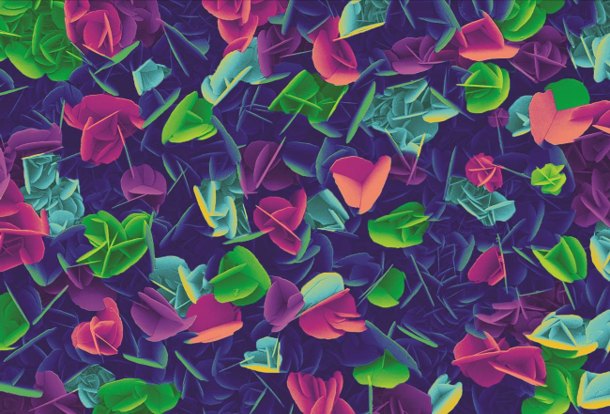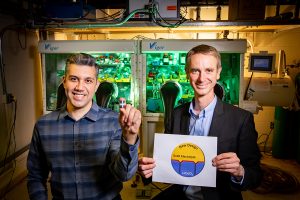


Welcome to the home page of the Paul Braun Research Group at the University of Illinois Urbana-Champaign. Our group members perform research in the fields of materials chemistry, polymers, biomaterials, organic and inorganic self-assembly, electronic materials and photonics.
In the News
From the lab to the battery start-up
by Mitch Jacoby, c&en
What drives entrepreneurial scientists to take an idea discovered in the lab and turn it into a business, especially in areas where other companies have failed?
The transition doesn’t happen in a puff of magic or a single eureka moment. “These companies don’t just come out of the ether from one unexpected lab development. There are many steps along the way,” says Paul V. Braun, a materials scientist at the University of Illinois Urbana-Champaign (UIUC), who cofounded Xerion Advanced Battery, where he serves as chief technology officer. The idea to launch a start-up may not sprout suddenly, but there are often decisive moments that drive the germination process.

For Xerion, which is located near Dayton, Ohio, one of those moments came when researchers discovered a valuable method for depositing battery materials on a metal current collector—an important step in making batteries. For SES, a spin-off from the Massachusetts Institute of Technology, a major advance resulted from MIT researchers figuring out how to make a safe electrolyte for batteries that feature metallic lithium electrodes. And for Nanotech Energy, which grew out of advances made at the University of California, Los Angeles, one turning point was when scientists realized that their novel form of graphene was an outstanding electrode material.
In each of these cases, the researchers recognized that their discoveries could be the start of something big. These companies have long moved past prototypes and early pilot-scale studies. They have partnered with large, well-known companies and have raised millions of dollars. If all goes well, their batteries may soon end up in electric vehicles and other types of brand-name consumer products.
Moving beyond an initial discovery requires a lot of confidence and a major investment of time, effort, and money. But that’s not enough to ensure that a company will do well. Timing is also critical. One of the keys to launching a successful start-up is anticipating an important need—such as powerful batteries to electrify transportation—long enough in advance to do the necessary R&D to win investor confidence in a company’s ability to compete in the market.
Read the full story: https://cen.acs.org/careers/entrepreneurship/lab-battery-start/100/i31
Extracting confidence: Braun, Zahiri’s team semifinalists in DOE American-made Geothermal Lithium Extraction Prize

At MatSE at Illinois our students are more than problem-solvers, they’re difference-makers in evolving our way of life. Just ask Paul Braun, Beniamin Zahiri and their crew of MatSE at Illinois undergraduate and graduate students who are one of 15 semifinalists in the U.S. Department of Energy’s American-made Geothermal Lithium Extraction Prize.
The MatSE at Illinois team, known as SelectPureLi, is being awarded $40,000 and moving on to phase two of the three-phase competition to further lithium extraction efforts.
Read the full story: https://matse.illinois.edu/news/extracting-confidence-braun-zahiris-team-semifinalists-in-doe-american-made-geothermal-lithium-extraction-prize
Materials Scientists Discover New Method to Manufacture Cathodes for Na Ion Battery

A new study from the Braun Group demonstrates a generalized electrochemical method to grow thick energy dense cathodes for Na ion batteries. This is the first demonstration of electrodeposition of thick ceramic oxide films of importance for sodium-based electrochemical energy storage.
The research team at the University of Illinois includes Materials Science and Engineering Professor Paul V. Braun; P.hD. student Arghya Patra and undergraduate student Jerome Davis III; and collaborators Professor Daniel P. Shoemaker and Professor Jian Min Zuo, along with members of their respective groups. All are researchers in the Materials Research Laboratory.
The new manufacturing method is of interest to both the basic materials science community given the new growth method demonstrated, and companies interested in new
cathodes for sodium-ion based energy storage-in particular, companies interested in grid energy storage. The grown materials exhibit nearly ideal electrochemical properties, and can be grown to thicknesses of relevance for industry.
Read the full story: https://matse.illinois.edu/news/40182
Read the related paper: Electrodeposition of atmosphere-sensitive ternary sodium transition metal oxide films for sodium-based electrochemical energy storage
Solid-state batteries line up for better performance

Solid-state batteries pack a lot of energy into a small space, but their electrodes are not good at keeping in touch with their electrolytes. Liquid electrolytes reach every nook and cranny of an electrode to spark energy, but liquids take up space without storing energy and fail over time. Researchers are now putting solid electrolytes in touch with electrodes made of strategically arranged materials – at the atomic level – and the results are helping drive better solid-state battery technologies.
A new study, led by University of Illinois Urbana-Champaign materials science and engineering professor Paul Braun, postdoctoral research associate Beniamin Zahiri, and Xerion Advanced Battery Corp. director of research and development John Cook, demonstrates how control over the atomic alignment of solid materials can improve the cathode-solid electrolyte interface and stability in solid-state batteries. The results are published in the journal Nature Materials.
Read the full story: https://news.illinois.edu/view/6367/1713475018
Read the full paper: Revealing the role of the cathode–electrolyte interface on solid-state batteries
| Braun Group Recent Publications |
|---|
| X. Yan, J. Diamond, N. Fritz, S. Matsuo, K.F. Rabbi, I. Zarin, N. Miljkovic, P.V. Braun and N. Sottos, Nickel-Silicon Interfacial Adhesion Strength Measured by Laser Spallation, Journal of Applied Physics, 135, 16, 165302 (2024). DOI: 10.1063/5.0198331 |
| S.B. Kang, G. Huang, G. Singhal, D. Xie, D. Hsieh, Y. Lee, A.A. Kulkarni, J.W. Smith, Q. Chen, K. Thornton, S. Sinha and P. V. Braun, Highly Ordered Eutectic Mesostructures via Template-Directed Solidification within Thermally Engineered Templates, Advanced Materials, 36, 15, 2308720 (2024). DOI: 10.1002/adma.202308720 |
| Y.B. Lee, B.A. Suslick, D. de Jong, G.O. Wilson, J.S. Moore, N.R. Sottos, P.V. Braun, A Self-Healing System for Polydicyclopentadiene Thermosets, Advanced Materials, 36, 11, 2309662 (2024). DOI: 10.1002/adma.202309662 |
| Y. Kim, C. Juarez-Yescas, D.W. Liao, M.K. Jangid, P. Joshi, H. Yang, B. Zahiri, P. Braun and N. Dasgupta, Thin Free-Standing Sulfide/Halide Bilayer Electrolytes for Solid-State Batteries Using Slurry Processing and Lamination, ACS Energy Letters, 9, 4, 1353-1360 (2024). DOI: 10.1021/acsenergylett.4c00092 |
| Z. Cheng, Yu-Ju Huang, B. Zahiri, P. Kwon, P.V. Braun and D.G. Cahill, Ionic Peltier Effect in Li-Ion Electrolytes, 26, 6708-6716 (2024). DOI: 10.1039/D3CP05998G |
| Y-Y, Lin, C. Juarez-Yescas, K-W. Lan, P.V. Braun, J.A. Krogstad, and N.H. Perry, Isolation of Grain vs. Intergranular Transport in Li1+xTixTa1-x SiO5 Suggests Concerted Ion Migration in a High-Voltage Stable Electrolyte from High-Throughput Descriptors, ACS Applied Energy Materials, 6, 22, 11468-11480 (2023). DOI: 10.1021/acsaem.3c01647 |